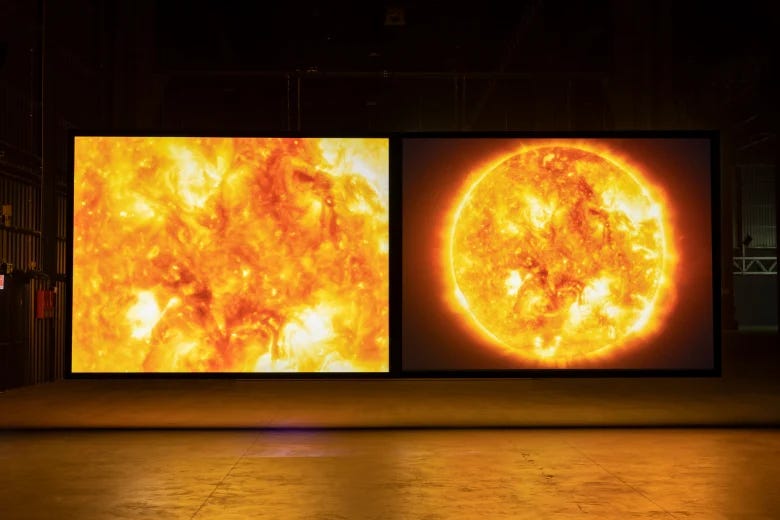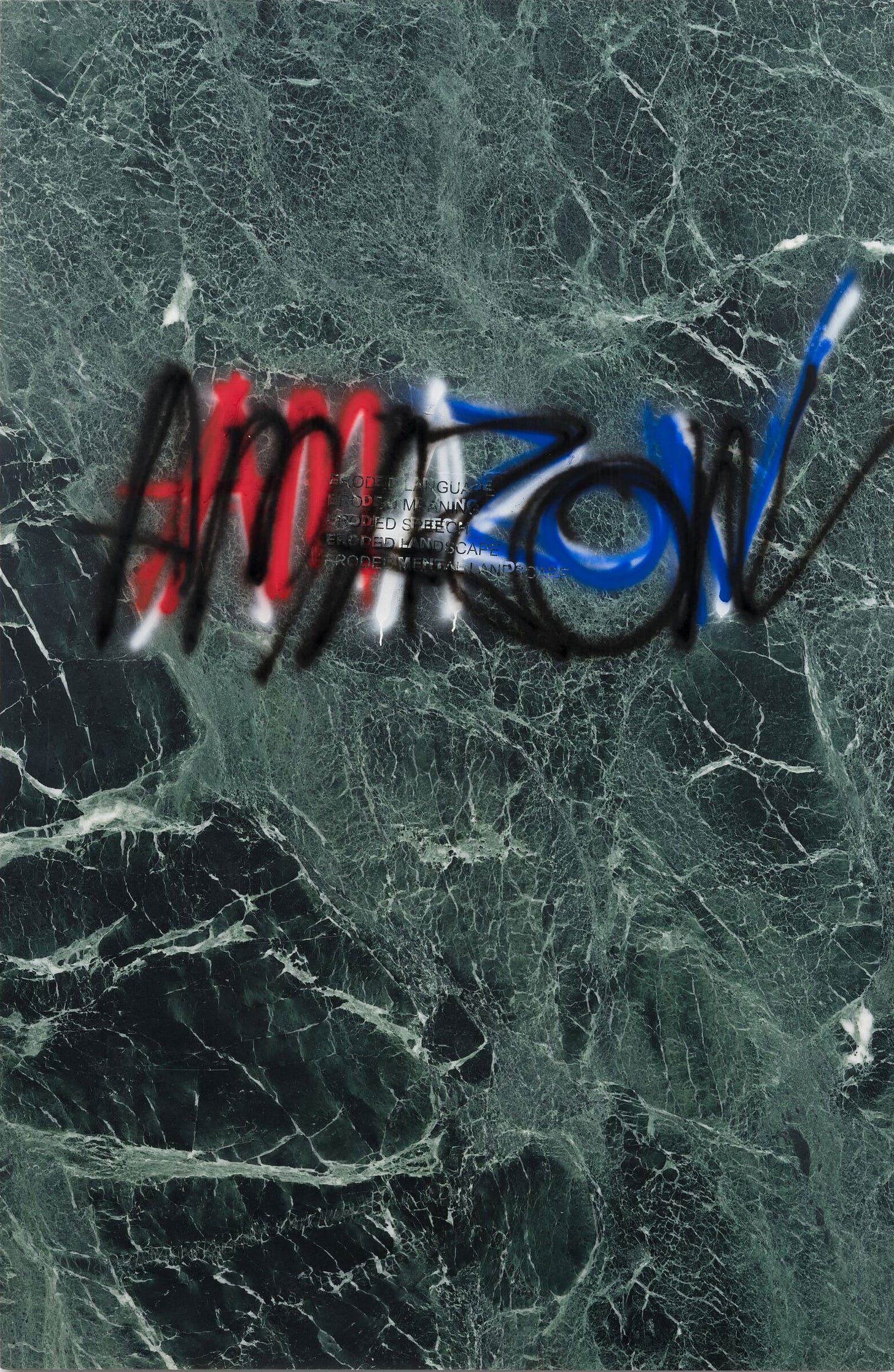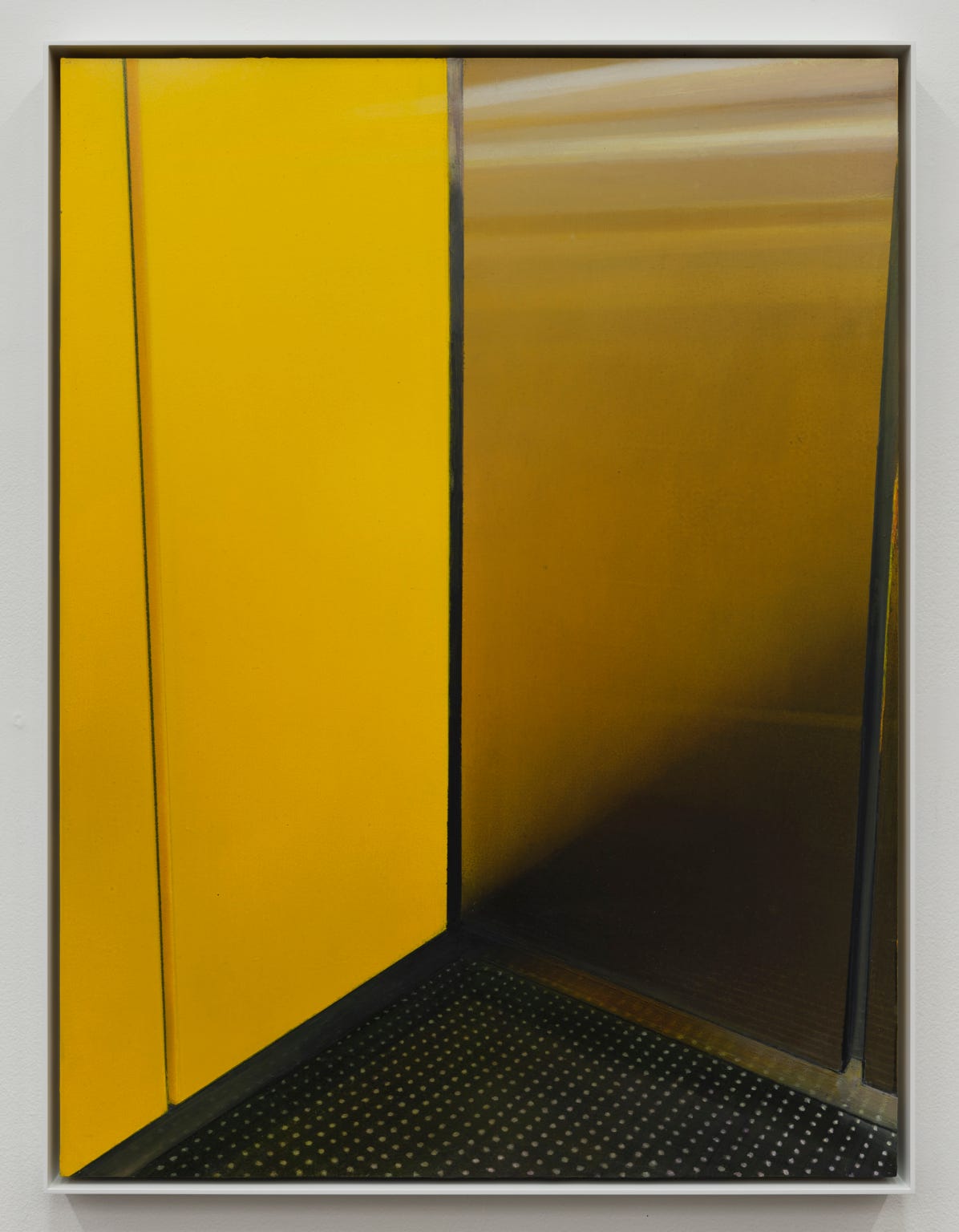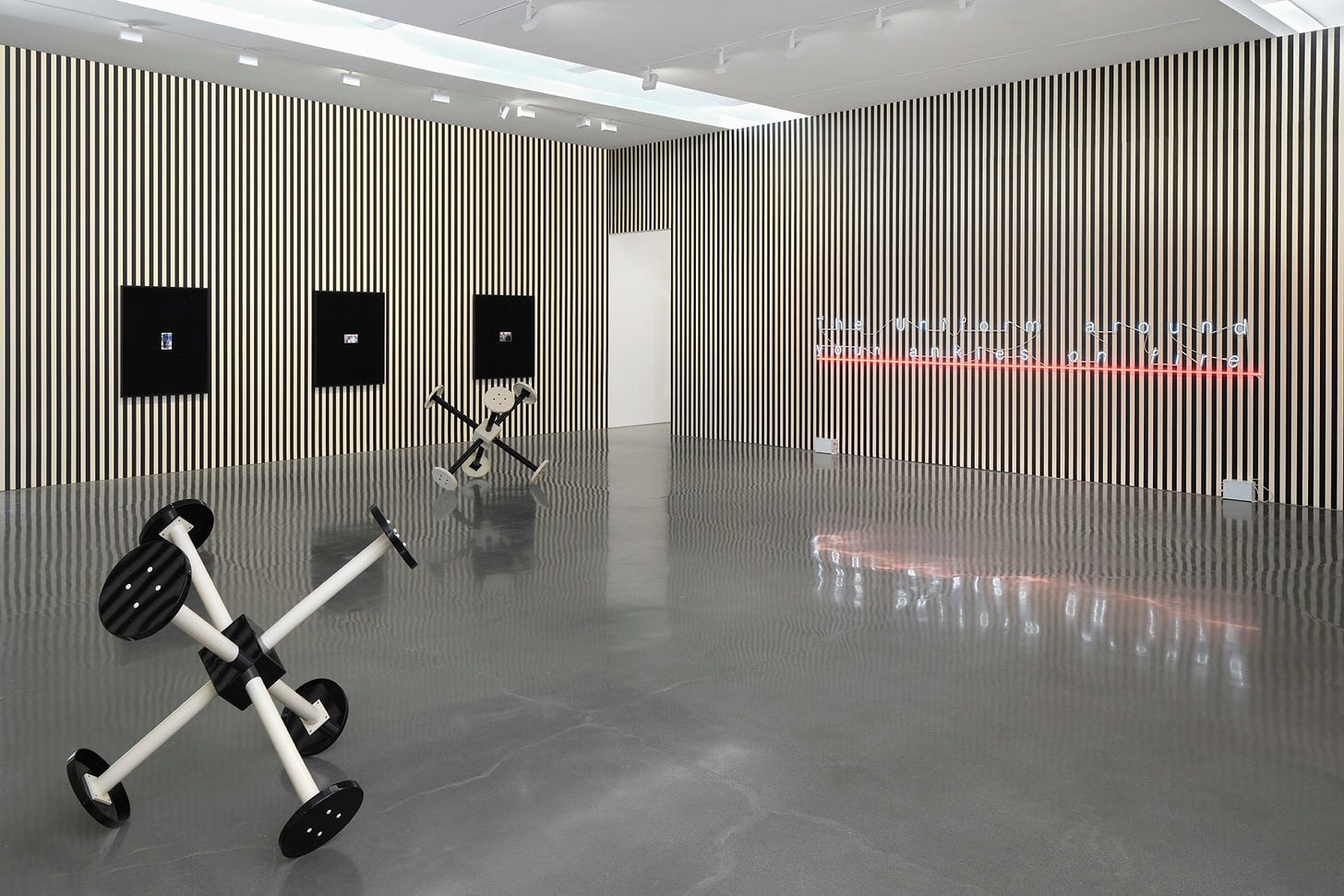Some Art in L.A.
On Analia Saban @ Sprüth Magers & Tanya Bonakdar; Steve McQueen @ Marian Goodman; Stefan Brüggemann & Harmony Korine @ Hauser & Wirth; Dike Blair @ Karma; Sable Elyse Smith @ Regen Projects
Analia Saban @ Sprüth Magers & Tanya Bonakdar

Let’s begin with the good. It’s hard to argue with Analia Saban’s wide ranging work on view at Tanya Bonakdar and Sprüth Magers in Los Angeles. This two-gallery show solidifies Saban as an alchemist of raw materials and cutting-edge (quite literally cutting-edge laser) technologies. Behind the grids (woven out of copper and engraved out of paper) of PC case fans (the kinds that get to whirring when your processor really heats up) there lies an anxiety about the advent of artificial intelligence and what it means for artists.
What is perhaps most important in Saban’s new body of work is that she has used photographic images for the first time. Some of them she has taken herself, as with her mouse-eared-and-button-nosed filter selfie taken in the stacks of the Getty Research Institute. Others she has grabbed from the web. Others are AI generated. Which are which is a curiosity but largely irrelevant. For an artist who has worked wonders with the materials of art making for more than a decade, what matters here is that the photographic image has become one more material amongst others.
I guess the way to put this is that nothing is being appropriated here. Because what Saban shows us, in finally turning to photographic images in her work, is that the image is obsolete, its representational status, its capacity for being appropriated, its being a little bit index, a little bit icon – all of this is, in a sense, over. What’s left is just a mass of organized pixels with a more or less “patterned integrity” (the phrase belongs to Hugh Kenner).
The same technical process that laser-cuts scaled-up circuit boards out of wood veneer is used for creating the photo-based works, which are laser engraved out of a graphite-layered encaustic. It’s what you might get when you combine Jasper Johns’ elliptical reticence with John Baldessari’s acute visual wit, and then hit the result with a heavy dose of anxiety about the cost of “intelligence” (visual or any other kind) going to zero. All of those hours of calc and coding and school in general? The priorities and values we thought were sacrosanct are being revalued at a rate that’s hard to fathom. Saban’s work manages to make this revaluation apparent, while couching it in an experimental craftsmanship that is hers alone.
Steve McQueen @ Marian Goodman
Not far behind is Steve McQueen’s Sunshine State (2022), which originally debuted in Milan at the Pirelli HangarBicocca and here inaugurates Marian Goodman’s new gallery space in Los Angeles. The installation, two side-by-side screens that receive the same projections on their fronts and backs, creates two viewing areas that can’t be seen together. Only as you walk from the front of the black box to the back do you get a sense of the full set up.
The footage itself combines filtered images of our sun’s swirling, chaotic, and always mesmerizing surface with portions of The Jazz Singer (1927), widely regarded as the first “talkie” and today condemned as “problematic” for its Jewish protagonist’s performance in blackface.
Apart from running the clipped movie footage forward on one screen and in reverse on the other, and also projecting the images in both positive and negative registers, McQueen intervenes in the footage by using a chroma keying effect on the blackface makeup that the movie’s star, Al Jolson, dons as the promising young jazz singer “Jack Robin.” In the climax of the movie, when “Jack” prepares to go on stage for the big dress rehearsal, what we now see is him effectively erasing his own face and head. From that point on, we no longer see Jack but rather an invisible man.
It’s at this point that commenters on McQueen’s work won’t fail to acknowledge that the artist’s special effects invoke Ralph Ellison’s landmark 1952 novel Invisible Man. (McQueen is on record saying as much.) Additionally, the voiceover that pervades McQueen’s installation tells the story of his father’s confrontation with racial violence while working as an orange picker in 1950s Florida (the “Sunshine State”) as part of a Jamaican guest-worker program (it’s a story that McQueen’s father only revealed at the end of his life). So the text, and subtext, of Sunshine State are race and family. And if those images of the blazing sun are as hard to parse as they are spectacular to view, then Cora Gilroy-Ware, who has commented extensively on this work, would have it that, in fact, “the sun serves as the connective tissue between 1927, the 1950s, and 2022,” because like the racism of The Jazz Singer, and like the racism that McQueen’s father experienced in Florida, and like the systemic racism that many believe is all encompassing today, the “sun [i.e. racism] has remained the same.”

Some may feel it’s enough to stop there and accept that this is just what Sunshine State is about. But it’s worth noting that in The Jazz Singer, Jack’s “racial pageantry” (the term belongs to Gilroy-Ware) allows him to overcome his own racial – i.e. Jewish – inheritance, not in the service of becoming a different race, but in overcoming the inheritance of race itself by becoming something else: an artist.
As much as Ellison’s novel may be an obvious touchpoint, McQueen’s intervention is surely more than a superficial emblem of that novel’s titular thematic. And if Ellison’s Invisible Man is salient here, then why not H. G. Wells’ The Invisible Man? The special effect on which McQueen’s Sunshine State turns has more in common with the 1933 hit movie adaptation of Wells’ story (and its 1950s TV revival) than with the character or plot of Ellison’s novel. Published a year after the U.S. Supreme Court’s notorious Plessy vs. Ferguson decision of 1896, Wells’ story itself could easily be read against the grain as an allegory of regulatory regimes of visibility. Furthermore, McQueen’s split-screen, palindromic presentation cuts equally against the linear storytelling of the films for which he has become justly famous. We should probably take such presentations seriously if we want to understand just what the artist, and this art, is about.
Stefan Brüggemann @ Hauser & Wirth
As much as Sunshine State holds rewards for those willing to delve deeper than superficial racial analyses might afford, Stefan Brüggemann’s White Noise at Hauser & Wirth should come with a sign that says “No Diving” lest one break one’s neck on the bottom of such a shallow pool of luxury cynicism. It’s like the new staple of the Los Angeles real estate market: overly-large, simplistic, pseudo-modern (a.k.a. generic contemporary) spec houses that retail in the tens of millions of dollars. As one architect friend of mine noted, they’re not houses, they’re just a bundle of “features.”
I couldn’t help thinking of this when looking at Eroded Painting (Amazon), (2021), which takes what would pass for standard high-end marble counter top, lifts it into the vertical plane, and then defaces it with the word “AMAZON” spray-painted in black, red, white, and blue (at issue here is the U.S.A., get it?). Other entries in this series include “AIR POLLUTION IS MIND POLLUTION” and “JUST GOING AROUND.” (I can hear John Oliver muttering his savagely deadpanned: “Cool.”)
Underneath these carefully staged attacks of graffiti one can just make out a more wishfully high-minded list of mantras that read: “Eroded Language. Eroded Meaning. Eroded Speech. Eroded Landscape. Eroded Mental Landscape.” Never before had the thought of perishing in a cliffside collapse felt so appealing.
The question here could be not whether the work is cynical – it most certainly is – but how cynical and in exactly what ways it is? Is it a dare to the collector class to consume it’s own fantasies of degradation? Is it an authentic attempt at giving material form to something like “luxury beliefs”? I say these “could be” the questions to wrestle with only because it’s not at all clear whether the answers have any relevance (actually, it is pretty clear).
Like those LA spec homes, Brüggemann’s products are just a collection of features that gesture at contemporary artistic tastes: high-end materials, a bourgeois nod to the authenticity of the “street,” some rasterized digital printing (“Cool”), and highly designed text that advertises “deep thought” while saying exactly nothing.

It’s at once a cruel irony and glimmer of faustian genius that Brüggemann’s Exit Door (In Gold We Trust) (2023), a crash-bar-operated exit door covered in gold leaf, isn’t functional. I can imagine its genesis however: there is Brüggemann’s unconscious, lounging in an RH Home showroom, sipping a Casamigos reposado, and looking for the exit. It knows this isn’t the place. It knows no art will ever come from here. But at the same time it’s just So. Damn. Comfortable.
Then an attractive “customer experience associate,” who is also mildly repellant in that undead sort of way, leans over and whispers, “Stefan, to be political it has to look nice.” All of a sudden the cushions feel softer, the drink tastes a little better, and that exit door… Well, that exit door is so far away it looks like it could be a nice painting. And Brüggemann’s unconscious says to itself, “Yes, I’ll make it gold.”
Harmony Korine @ Hauser & Wirth
It doesn’t help Brüggemann’s case that the gallery has given a filmmaker ample room to experiment with painting down the hall. Harmony Korine’s work, derived from his newest film AGGRO DR1FT, which features ample footage shot with infrared cameras and run through the newest (at the time) AI engines, are strangely compelling. The masked figures, the guns, the fast boats, the gradients of electric color, all combine in images at once lurid, tawdry, and menacing.
Korine would have been wise to leave out the double-sided video works entitled Children of Zion (2023), or to make them the entirety of the show. The gunmen captured by the machine vision of the infrared camera give off just as much “heat” as the paintings, but the fact that they are in motion, and on monitors, gives away that Korine isn’t at home in the liquid medium of paint.
The pictures work from a certain distance, the same distance that one would approach screens of equal size. But good painting rewards close looking, and there’s little reward for getting up close to Korine’s canvases. It’s also not clear that there is enough distance traveled between the film’s imagery and the painted pictures. Korine has noted that he really “pushed” the paint colors. But monitors produce their own light. Paintings can only reflect it. And while on the evidence of the video pieces it appears that Korine and crew were going for something like equivalence between video and painting, it would have been better to go for something excessive, which is more Korine’s house style anyway.
Dike Blair @ Karma
In fact, Korine would be well served to spend some time with Dike Blair’s paintings, which also translate photographs – or at least a photographic sensibility; a photographic mindedness – into the medium of paint in order to make paintings, not just pictures of photo-based materials.
Blair’s works, almost all from the past three years, continue the kind of diaristic work for which he has become well known: pictures (oil on aluminum all) of the decidedly unspectacular surrounds that the artist finds himself in – that we all find ourselves in, when we’re really looking: glasses and cups, windows, elevator interiors, parking lots, road sides, an so on.
It is the anti-Brüggemann: a situational awareness and sensibility utterly lacking in “features” for their own sake, and devoid of any status that doesn’t issue from that moment of encounter or reflection that casts even the most quotidien accoutrements of the world as images worth taking, making, and remembering.
On the occasion of Blair’s opening, I spent far too long arguing with some old and new friends for the obsolescence of the image in the face of AI. I was extending thoughts that had come up when I viewed Saban’s newest photo-based work, and these thoughts seemed similarly relevant to – and challenged by – Blair’s pictures. This is not to suggest that Blair’s pictures are immune from the same overhaul of our image intelligence that AI is going to undertake; it is to note, however, that Blair’s pictures are exactly the kinds, or at least seem like they could be the kinds, that the algorithm is least likely to generate. Not because it can’t, but because these kinds of images are so difficult to make meaningful for anyone other than their creator, and so they are the least likely to be called up in the service of some other enterprise (advertising, marketing, design, gaming, etc.). And it’s Blair’s achievement to make them meaningful as paintings, such that they can stand on their own whether indexed to Blair’s biography or not
There’s a parenthetical in one of Wittgenstein’s notebooks that goes like this: “I am always reminded of one of those insipid photographs of a piece of scenery which is interesting to the person who took it because he was there himself, experienced something, but which a third party looks at with justifiable coldness; in so far as it is ever justifiable to look at something with coldness.” This comes on the heel of a passage that argues for the role of the artist, the job of art being to reproduce not the scenery but the experience, and not the photographer’s experience, but the experience that belongs to that scene, regardless of who is viewing it.
Not every one of Blair’s paintings gets to this point, but it’s this point that they are trying to get to, with more or less success. The framing and composition remain artifacts of the image, but the surface and the color (e.g. in the industrial panels of that elevator interior, or the difference between a dashboard and violet night), the facture that is at turns fumbling and exquisite in just the right places, is as far from machine intelligence as one can hope for at present.
Sable Elyse Smith @ Regen Projects
It’s hard to say whether the lack of novelty in Sable Elyse Smith’s work is an allegory of the “carceral,” which has been a generative and personal topic of hers from the jump, or a submission to the market’s demand for the identifiable over the idiosyncratic. If the former, then the consistent reappearance of certain appropriated forms – such as the scaled-up pages of a children’s guide to court and prison, or the “jacks”-shaped sculptures based upon prison furniture – would effectively invoke one of the most pernicious indignities that incarcerated people are made to suffer: boredom. If the latter, then she could hardly be blamed for it: the market wants what the market wants.
It’s just that for artists’s of the multidisciplinary, conceptual persuasion, signature moves aren’t mediums, and they can grow tiresome, and sometimes appear that way from the beginning. The neon “poetics” for which Smith is lauded are no more profound than Brüggemann’s lame koans; as neon signs they quite literally opt for flash over substance. And how to parse a series of photographic works such as GROUP OF THUGS (2023), a series of ten polaroid-sized identical pictures, each engulfed by substantial “antique white” matboard, and titled Young Thug IV through XIV? The pictures show a boy of maybe 11 or 12 years old, in white shirt and red shorts with an American-flag bandana wrapped around his head. He’s standing against a white door, with a grownup just to his left holding some sort of implement, perhaps a pen. Close inspection reveals height markings on the door, presumably a measure of the kid’s growth.

Again, the subtext is politics and race: the kid is white, the colors “don’t run,” and the caption is redolent of how conservative media (both social and mainstream) likes to demean young black kids whose pictures show up on our screens. “Young Thug,” it’s also worth pointing out, is one of the stage names of a famous rapper who is currently incarcerated while facing trial in Atlanta on a suite of federal RICO charges.
While the work may be about the “grammar” of image and text and, like some meditative practice, intended to awaken us to the operations of our own senses and sensibilities lest we lazily fall prey to the false consciousness of our biases and priors, it may equally be about the marshaling of highly recognizable aesthetic strategies (seriality, appropriation, nominalism, etc.) now repackaged with exactly those biases and priors as a brand wrapping designed to catch a curator’s eye.
How this work models liberation or abolition is hard to say. Perhaps it’s not meant to. It may be that Smith is content with a strategy of “critique” that is meant to “interrogate” and “expose” the subtle and not-so-subtle mechanisms of “carcerality” that persist today. Yet critique is our academic style par excellence, and an art that confronts the tragedy of incarceration must try for something more than the fatalism of the academic stance; unless, of course, the fatalism is the point.










